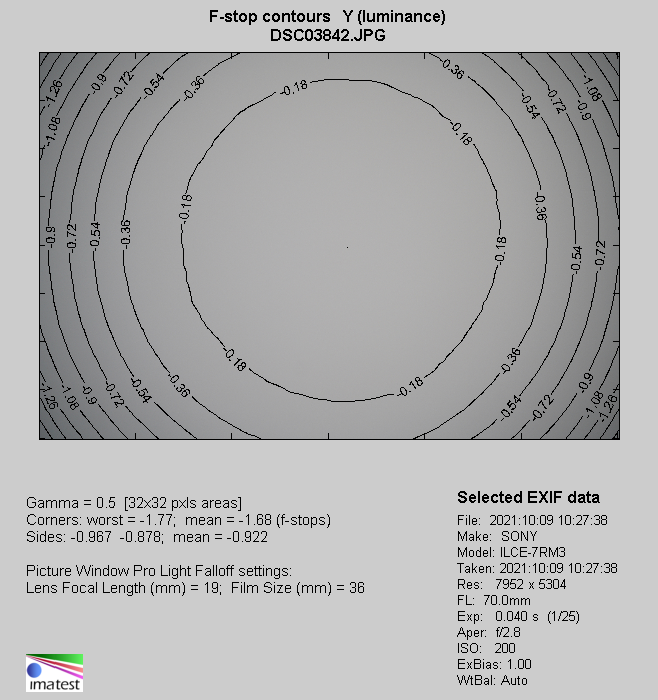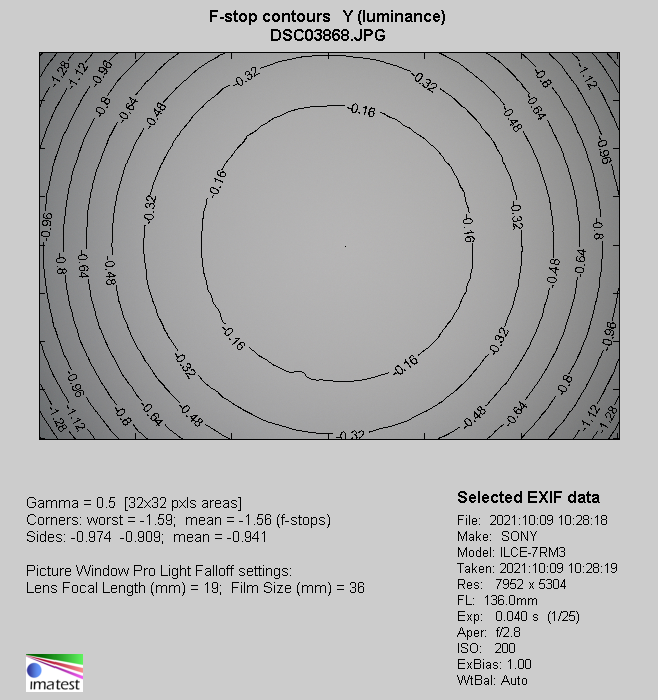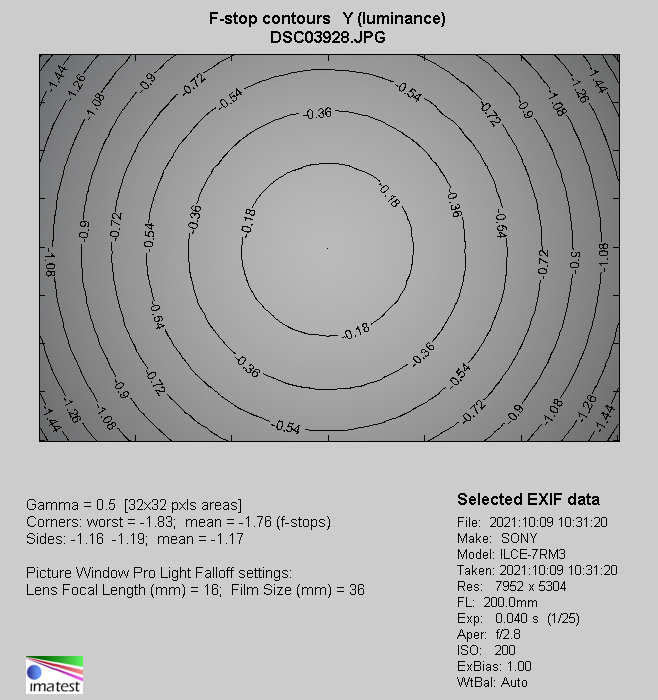Sony FE 70-200 mm f/2.8 GM OSS II
8. Vignetting
| A7R III, APS-C, JPEG, 70ámm, f/2.8 | A7R III, APS-C, JPEG, 70ámm, f/4.0 |

|

|
| A7R III, APS-C, JPEG, 135ámm, f/2.8 | A7R III, APS-C, JPEG, 135ámm, f/4.0 |

|

|
| A7R III, APS-C, JPEG, 200ámm, f/2.8 | A7R III, APS-C, JPEG, 200ámm, f/4.0 |

|

|
On the smaller APS-C sensor vignetting is visible only and solely at the maximum relative aperture and even in that place you could hardly call its level problematic. At the 70 mm focal length and by f/2.8 aperture brightness loss in frame corners amounts to 13% (-0.40 EV) and it drops to a completely negligible value of 2% (-0.06 EV) on stopping down the aperture to f/4.0.
Please Support UsIf you enjoy our reviews and articles, and you want us to continue our work please, support our website by donating through PayPal. The funds are going to be used for paying our editorial team, renting servers, and equipping our testing studio; only that way we will be able to continue providing you interesting content for free. |
- - - - - - - - - - - - - - - - - - - - - - - - - - - - - - - - - - - - - - - - - - - - - - - -
A very similar situation can be noticed at 135 mm where, by f/2.8, vignetting reaches 15% (-0.46 EV) and drops again to 2% (-0.05 EV) on stopping down the aperture to f/4.0.
A tad more problems can be noticed at the maximum focal length where, by f/2.8, f/4.0, and f/5.6 vignetting levels are, respectively: 23% (-0.75 EV), 8% (-0.23 EV), and 2% (-0.05 EV).
Now let's check the situation on full frame – appropriate thumbnalis are presented below.
| A7R III, FF, JPEG, 70ámm, f/2.8 | A7R III, FF, JPEG, 70ámm, f/4.0 |

|

|
| A7R III, FF, JPEG, 135ámm, f/2.8 | A7R III, FF, JPEG, 135ámm, f/4.0 |

|

|
| A7R III, FF, JPEG, 200ámm, f/2.8 | A7R III, FF, JPEG, 200ámm, f/4.0 |

|

|
This time vignetting is far more conspicuous but, taking into account mirrorless standards, the situation cannot be called bad. At 70 mm and by f/2.8 light fall-off in frame corners amounts to 44% (-1.68 EV), then it decreases to 23% (-0.77 EV) on stopping down the aperture to f/4.0. All problems end by f/5.6 and f/8.0, where we got, respectively, 14% (-0.42 EV), and 8% (-0.23 EV).
After changing the focal length to 135 mm the results remain almost the same. By f/2.8 vignetting amounts to 42% (-1.56 EV), by f/4.0 it reaches 20% (-0.66 EV), and by f/5.6 it drops to 11% (-0.33 EV). By f/8.0 the problem disappears practically completely because the value we got amounted to just 5% (-0.15 EV).
A bit higher results you see at the maximum focal length. After employing f/2.8 you lose as much as 46% (-1.76 EV) in frame corners, when you pass to f/4.0 vignetting decreases to 26% (-0.88 EV). By f/5.6 and f/8.0 apertures we got, respectively: 15% (-0.49 EV), and 8% (-0.24 EV).
After comparing the Sony to the Nikkor Z 70-200 mm f/2.8 you have to admit the Sony slightly prevails over its rival. The Nikkor's vignetting was lower only at 70 mm; at 135 and 200 mm that lens fared weaker.
| Sony A7R III, 70ámm, JPEG, f/2.8 |
 |
| Sony A7R III, 135ámm, JPEG, f/2.8 |
 |
| Sony A7R III, 200ámm, JPEG, f/2.8 |
 |






